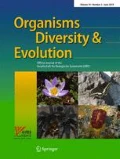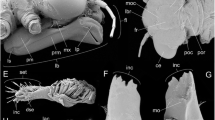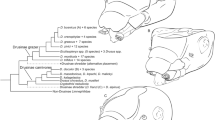Abstract
Diplura (two-pronged bristletails) are key to our understanding of hexapod head evolution. A sister group relationship with Ectognatha (=Insecta), comprising bristletails, silverfish and winged insects, is advocated in most modern studies, however, homologization of head muscles and endoskeletal elements between Diplura and Ectognatha is still lacking. Here, we present the first homologization of a number of head muscles and endoskeletal structures between Diplura and Ectognatha. A homologization of these structures is possible if a range of species, both from Japygidae and Campodeidae, are studied in order to reconstruct the potential groundplan characteristics and account for inner anatomy variations within Diplura. Japygidae and Campodeidae show differences in the origin, insertion, and presence of mandibular and maxillary muscles as well as the shape of the maxillary cardo. Taking into account recent embryological studies on the formation of the endoskeleton in Protura, Collembola and Diplura, we furthermore reconstruct the potential evolution of the endoskeleton in early Hexapoda. The tentorium is a defining feature of dicondylic insects (including Archaeognatha) while anterior and posterior cephalic invaginations (the later tentorial pits of dicondylic insects) are groundplan features of Hexapoda. Additionally, we clarify the composition of the gnathal pouches (i.e. the type of entognathy) in Diplura and Collembola. The pouches in Diplura are posteriorly separated, similar to the state encountered in Collembola. This contrasts to former studies emphasizing the differences in the ellipuran and dipluran type of entognathy.










Similar content being viewed by others
References
Beckmann, F., Herzen, J., Haibel, A., Müller, B., & Schreyer, A. (2008). High density resolution in synchrotron-radiation-based attenuation-contrast microtomography. Proceedings of SPIE, 7078, 70781D–70781D–13. doi:10.1117/12.794617.
Beutel, R. G., Friedrich, F., Ge, S. Q., & Yang, X. K. (2014). Insect morphology and phylogeny: a textbook for students of entomology. Berlin: De Gruyter.
Bitsch, J. (1963). Morphologie céphalique des machilides (Insecta thysaunura). Annales des Sciences Naturelles, Zoologie, 12(5), 585–706.
Blanke, A., Wipfler, B., Letsch, H., Koch, M., Beckmann, F., Beutel, R., & Misof, B. (2012). Revival of Palaeoptera—head characters support a monophyletic origin of Odonata and Ephemeroptera (Insecta). Cladistics, 28(6), 560–581. doi:10.1111/j.1096-0031.2012.00405.x.
Blanke, A., Koch, M., Wipfler, B., Wilde, F., & Misof, B. (2014). Head morphology of Tricholepidion gertschi indicates monophyletic Zygentoma. Frontiers in Zoology, 11(1), 16. doi:10.1186/1742-9994-11-16.
Blanke, A., Machida, R., Szucsich, N. U., Wilde, F., & Misof, B. (2015). Mandibles with two joints evolved much earlier in the history of insects: dicondyly is a synapomorphy of bristletails, silverfish and winged insects. Systematic Entomology, 40(2), 357–364. doi:10.1111/syen.12107.
Chaudonneret, J. (1948). Le labium des thysanoures (Insectes aptérygotes). Annales des Sciences Naturelles, Zoologie, 11(10), 1–26.
Chaudonneret, J. (1950). La morphologie céphalique de Thermobia domestica (Packard) (Insecte Aptérigota Thysannoure). Annales des Sciences Naturelles, Zoologie, 12, 145–302.
Dallai, R. (1998). New findings on dipluran spermatozoa. In The Fifth European Congress of Entomology (Vol. 1, p. 291). Ceské Budejovice: Book of Abstracts.
DuPorte, E. M. (1957). The comparative morphology of the insect head. Annual Review of Entomology, 2(1), 55–70. doi:10.1146/annurev.en.02.010157.000415.
Fiala, J. C. (2005). Reconstruct: a free editor for serial section microscopy. Journal of Microscopy, 218(1), 52–61. doi:10.1111/j.1365-2818.2005.01466.x.
Folsom, J. W. (1900). The development of the mouthparts of Anurida maritima Guér. Bulletin of the Museum of Comparative Zoology, 36, 87–157.
François, J. (1970). Squelette et musculature céphalique de Campodea chardardi Condé (Diplura: Campodeidae). Zoologische Jahrbücher der Anatomie, 87, 331–376.
François, J., Dallai, R., & Yin, W. Y. (1992). Cephalic anatomy of Sinentomon erythranum Yin (Protura : Sinentomidae). International Journal of Insect Morphology and Embryology, 21(3), 199–213. doi:10.1016/0020-7322(92)90016-G.
Fukui, M. (2010). Embryological studies on Baculentulus densus (Imadaté) (Hexapoda: Protura, Acerentomidae). University of Tsukuba, Tsukuba, doctoral dissertation.
Hennig, W. (1965). Phylogenetic systematics. Annual Review of Entomology, 10(1), 97–116. doi:10.1146/annurev.en.10.010165.000525.
Hoffmann, R. W. (1908). Über die Morphologie und Funktion der Kauwerkzeuge und über das Kopfnervensystem von Tomocerus plumbeus L. (III. Beitrag zur Kenntnis der Collembolen). Zeitschrift für Wissenschaftliche Zoologie, 89, 598–689. +5 plates
Ikeda, Y., & Machida, R. (1998). Embryogenesis of the dipluran Lepidocampa weberi Oudemans (Hexapoda, Diplura, Campodeidae): external morphology. Journal of Morphology, 237(2), 101–115. doi:10.1002/(SICI)1097-4687(199808)237:2<101::AID-JMOR2>3.0.CO;2-4.
Ikeda, Y., & Machida, R. (2001). Embryogenesis of the dipluran Lepidocampa weberi Oudemans (Hexapoda: Diplura, Campodeidae): formation of dorsal organ and related phenomena. Journal of Morphology, 249(3), 242–251. doi:10.1002/jmor.1052.
Klass, K. (2009). A critical review of current data and hypotheses on hexapod phylogeny. Proceedings of the Arthropodan Embryological Society of Japan, 43, 3–22.
Koch, M. (1997). Monophyly and phylogenetic position of the Diplura (Hexapoda). Pedobiologia, 41, 9–12.
Koch, M. (2000). The cuticular cephalic endoskeleton of primarily wingless hexapods: ancestral state and evolutionary changes. Pedobiologia, 44(3–4), 374–385. doi:10.1078/S0031-4056(04)70056-6.
Koch, M. (2001). Mandibular mechanisms and the evolution of hexapods. Annales de la Société Entomologique de France (N.S.), 37, 129–174.
Kukalová-Peck, J. (1987). New Carboniferous Diplura, Monura, and Thysanura, the hexapod ground plan, and the role of thoracic side lobes in the origin of wings (Insecta). Canadian Journal of Zoology, 65(10), 2327–2345. doi:10.1139/z87-352.
Luan, Y., Mallatt, J. M., Xie, R., Yang, Y., & Yin, W. (2005). The phylogenetic positions of three basal hexapod groups (Protura, Diplura, and Collembola) based on ribosomal RNA gene sequences. Molecular Biology and Evolution, 22(7), 1579–1592. doi:10.1093/molbev/msi148.
Manton, S. M. (1977). The Arthropoda—habits, functional morphology and evolution. Oxford: Clarendon Press.
Manton, S. M., & Harding, J. P. (1964). Mandibular mechanisms and the evolution of arthropods. Philosophical Transactions of the Royal Society of London. Series B, Biological Sciences, 247(737), 1–183. doi:10.1098/rstb.1964.0001.
Matsuda, R. (1965). Morphology and evolution of the insect head. Memoirs of the American Entomological Institute, 1, 1–334.
Misof, B., Liu, S., Meusemann, K., Peters, R. S., Donath, A., Mayer, C., et al. (2014). Phylogenomics resolves the timing and pattern of insect evolution. Science, 346(6210), 763–767. doi:10.1126/science.1257570.
Ogurreck, M., Wilde, F., Herzen, J., Beckmann, F., Nazmov, V., Mohr, J., et al. (2013). The nanotomography endstation at the PETRA III Imaging beamline. Journal of Physics Conference Series, 425(18), 182002. doi:10.1088/1742-6596/425/18/182002.
Pohl, H. (2010). A scanning electron microscopy specimen holder for viewing different angles of a single specimen. Microscopy Research and Technique, 73(12), 1073–1076. doi:10.1002/jemt.20835.
Remane, A. (1952). Die grundlagen des natürlichen Systems, der vergleichenden Anatomie und der Phylogenetik. Leipzig: Akademische Verlagsgesellschaft Geest & Portig.
Richter, S., Moeller, O. S., & Wirkner, C. S. (2009). Advances in crustacean phylogenetics. Arthropod Systematics and Phylogeny, 67(2), 275–286.
Sekiya, K., & Machida, R. (2011). Formation of the entognathy of Dicellurata, Occasjapyx japonicus (Enderlein, 1907) (Hexapoda: Diplura, Dicellurata). Soil Organisms, 83(3), 399–404.
Snodgrass, R. E. (1935). Principles of Insect Morphology. ix + 667 pp.
Snodgrass, R. E. (1947). The insect cranium and the “epicranial suture”. Smithsonian Miscellaneos Collections, 107, 1–52.
Snodgrass, R. E. (1951). Comparative studies on the head of mandibulate arthropods. Ithaca, N.Y.: Comstock Pub.
Snodgrass, R. E. (1960). Facts and theories concerning the insect head. Smithsonian Miscellaneous Collections, 142(1), 1–61.
Stampanoni, M., Marone, F., Modregger, P., Pinzer, B., Thüring, T., Vila‐Comamala, J., et al. (2010). Tomographic hard X‐ray phase contrast micro‐ and nano‐imaging at TOMCAT. AIP Conference Proceedings, 1266, 13–17. doi:10.1063/1.3478189.
Sturm, H. & Machida, R. (2001) Archaeognatha. Handbook of zoology, Vol. IV: Arthropoda: Insecta (ed. by N. P. Kristensen and R. G. Beutel). Berlin: De Gruyter.
Tomizuka, S., & Machida, R. (2015a). Embryonic development of a collembolan, Tomocerus cuspidatus Börner, 1909: with special reference to the development and developmental potential of serosa (Hexapoda: Collembola, Tomoceridae). Arthropod Structure & Development, 44(2), 157–172. doi:10.1016/j.asd.2014.12.004.
Tomizuka, S., & Machida, R. (2015b). Tentorial invaginations of the collembolan Tomocerus cuspidatus Börner, 1909 (Hexapoda: Collembola, Tomoceridae). Proceedings of the Arthropodan Embryological Society of Japan. (in press)
Tuxen, S. L. (1952). Über das sogenannte Tentorium der Proturen. Trans 9th Internat Congr Ent, 1, 143–146.
Tuxen, S. L. (1964). The Protura. Paris: Hermann.
Uesugi, K., Hoshino, M., Takeuchi, A., Suzuki, Y., & Yagi, N. (2012). Development of fast and high throughput tomography using CMOS image detector at SPring-8. Proceedings of SPIE, 8506, 85060I.
von Lieven, A. F. (2000). The transformation from monocondylous to dicondylous mandibles in the Insecta. Zoologischer Anzeiger, 239(2), 139–146.
Wipfler, B., Machida, R., Müller, B., & Beutel, R. G. (2011). On the head morphology of Grylloblattodea (Insecta) and the systematic position of the order, with a new nomenclature for the head muscles of Dicondylia. Systematic Entomology, 36(2), 241–266. doi:10.1111/j.1365-3113.2010.00556.x.
Yushkevich, P. A., Piven, J., Hazlett, H. C., Smith, R. G., Ho, S., Gee, J. C., & Gerig, G. (2006). User-guided 3D active contour segmentation of anatomical structures: significantly improved efficiency and reliability. NeuroImage, 31(3), 1116–1128. doi:10.1016/j.neuroimage.2006.01.015.
Acknowledgments
Thomas Wesener kindly loaned specimens of Atlasjapyx cf. atlas; Nikolaus U. Szucsich determined the species and gave useful advice during the preparation of the mansucript and the review process. We additionally thank one anonymous reviewer. Peter T. Rühr, Makiko Fukui, Shigekazu Tomizuka, and Rolf G. Beutel are thanked for extremely useful discussion during the final preparation of this manuscript. Kaoru Sekiya collected Metriocampa sp., L. weberi, O. japonicus, and O. akiyamae; Alex Böhm collected C. aquilionaris. Cyrille d’Haese provided the majority of collembolans; Steven Yanoviak collected M. cundinamarcensis. Felix Beckmann, Fabian Wilde (both HZG / DESY), Marco Stampanoni, Peter Modregger and Rajmund Mokso (all PSI) as well as Kentaro Uesugi (SPring-8) provided excellent support at the synchrotron facilities. Bernhard Misof is thanked for his constant and unrelenting encouragement to AB.
Author information
Authors and Affiliations
Corresponding author
Ethics declarations
Conflict of interest
The authors declare that they have no competing interests.
Funding statement
Scanning was financed by DESY (proposal no. I-20090211, I-20100029 and I-20120065), PSI (20100137, 20110069 and 20140056) and SPring-8 (2014B1046) which is gratefully acknowledged. AB was financed by a post-doc fellowship of the Japanese Society for the Promotion of Science (JSPS ID: P14071), by a research fellowship of the Deutsche Forschungsgemeinschaft (DFG ID: BL 1355/1-1) and additionally supported by the joint research program of the DAAD and the University of Tsukuba (ID 57060275). RM received a grant-in-aid from the JSPS (Scientific Research C: 25440201).
Electronic supplementary material
Below is the link to the electronic supplementary material.
ESM_1
Muscle homologization between Diplura and dicondylic insects in MS-Excel format. Note that table one shows the muscle homologization while table two shows the origins and insertions of each muscle. (XLS 112 kb)
ESM_2
3D model of Atlasjapyx in .blend format (BLEND 58092 kb)
ESM_3
TIFF image stack of the reconstructed microCT dataset of Atlasjapyx in avi format for easy browsing through the stack. Mandible (red), maxillae (dark blue), hypopharyngeal fulturae (light blue), head capsule (purple). Note that the original TIFF image stack is 2560x2560 pixel with 2404 single images. The original dataset is available upon request due to the large size. (AVI 53983 kb)
Rights and permissions
About this article
Cite this article
Blanke, A., Machida, R. The homology of cephalic muscles and endoskeletal elements between Diplura and Ectognatha (Insecta). Org Divers Evol 16, 241–257 (2016). https://doi.org/10.1007/s13127-015-0251-5
Received:
Accepted:
Published:
Issue Date:
DOI: https://doi.org/10.1007/s13127-015-0251-5




